Author: Marshall Schott

Flaked oats are an unmalted grain that have had their starches gelatinized by pressure and heat during the flaking process, meaning they can be used without a cereal mash, which can’t be said for non-flaked grains like steel cut oats. The creaminess flaked oats purportedly imparts in a beer stems from the high beta glucan content, a gum produced during the malting process by the breakdown of hemicellulosic cell walls. Traditionally, brewers using grists consisting of high amounts of such adjuncts would employ a beta glucan mash rest at 104°F/40°C, during which beta glucanese enzymes work to dissolve the beta glucans thereby making for an easier lauter.
Up until a couple years ago, if I’d been asked what styles of beer benefit from flaked oats, my response would have been limited to Stouts and Porters, in which oats might make up 10% of the grist. That’s certainly not the case these days, as utilizing relatively high amounts of flaked oats has become a popular way to add a soft, elegant mouthfeel to Hazy IPA, an inclusion also said to contribute to this style’s notably hazy appearance and sought after “juicy” character.
As a lover of clear beer, I’d avoided brewing one of these murky abominations due my belief their haze was a function of yeast in suspension or otherwise shoddy brewing process. However, a couple experiences forced me to question these opinions, the first one being our collaborative xBmt with Ed Coffey from Ales Of The Riverwards. His HopWards Pale Ale was delicious, and the fact the gelatin fined sample retained a similar level of haze as the non-fined sample seemed to indicate yeast wasn’t the culprit. And then, a reader of Brülosophy was kind enough to share many popular commercial examples of Hazy IPA with me, none of which had what I typically expect from a beer with yeast in suspension. My focus then shifted to the other novel aspects of the style, such as the heavy use of flaked oats. Is it really a necessary component, or does the character it is presumed to impart come from something else?
| PURPOSE |
To evaluate the differences between a Hazy IPA made with flaked oats and the same beer made without flaked oats but an otherwise similar recipe.
| METHODS |
Since this was my first time brewing this style and I wanted to avoid as much bullshit criticism as possible, I relied on Ed’s HopWards recipe as the main inspiration for my recipe, making some changes in the hops based on what I had available at the time. BeerSmith calculations showed that swapping 18% of the Maris Otter grist with flaked oats had no impact on OG, which meant each batch would be of similar weight despite differing constitution.
Hazy Daze NEIPA
Recipe Details
| Batch Size | Boil Time | IBU | SRM | Est. OG | Est. FG | ABV |
|---|---|---|---|---|---|---|
| 5.5 gal | 60 min | 60.1 IBUs | 4.2 SRM | 1.057 | 1.013 | 5.8 % |
| Actuals | 1.057 | 1.01 | 6.2 % | |||
Fermentables
| Name | Amount | % |
|---|---|---|
| Pale Malt, Maris Otter | 10.125 lbs | 81.82 |
| Oats, Flaked | 2.25 lbs | 18.18 |
Hops
| Name | Amount | Time | Use | Form | Alpha % |
|---|---|---|---|---|---|
| Columbus/Tomahawk/Zeus (CTZ) | 11 g | 60 min | Boil | Pellet | 13.1 |
| Centennial | 30 g | 15 min | Boil | Pellet | 9.9 |
| Centennial | 30 g | 5 min | Boil | Pellet | 9.9 |
| Citra | 30 g | 5 min | Boil | Pellet | 13.4 |
| Galaxy | 30 g | 5 min | Boil | Pellet | 15 |
| Citra | 60 g | 3 days | Dry Hop | Pellet | 13.4 |
| Centennial | 30 g | 3 days | Dry Hop | Pellet | 9.9 |
| Galaxy | 30 g | 3 days | Dry Hop | Pellet | 15 |
Yeast
| Name | Lab | Attenuation | Temperature |
|---|---|---|---|
| London Ale III (1318) | Wyeast Labs | 73% | 64°F - 74°F |
Notes
| Water Profile: Ca 135 | Mg 1 | Na 10 | SO4 71 | Cl 186 |
Download
| Download this recipe's BeerXML file |
In keeping with popular approaches to brewing this style, I chose to use a yeast strain that many have come to identify as quintessential, Wyeast 1318 London Ale III, and built a single large starter using 2 packs the morning prior to brewing.
Later that day, after the sun had set, my assistant accompanied me to the garage to help prepare for the following morning’s brew day, starting with measuring out and milling the slightly different amounts of Maris Otter.
I then weighed out the flaked oats and tossed them on top of the milled grain.
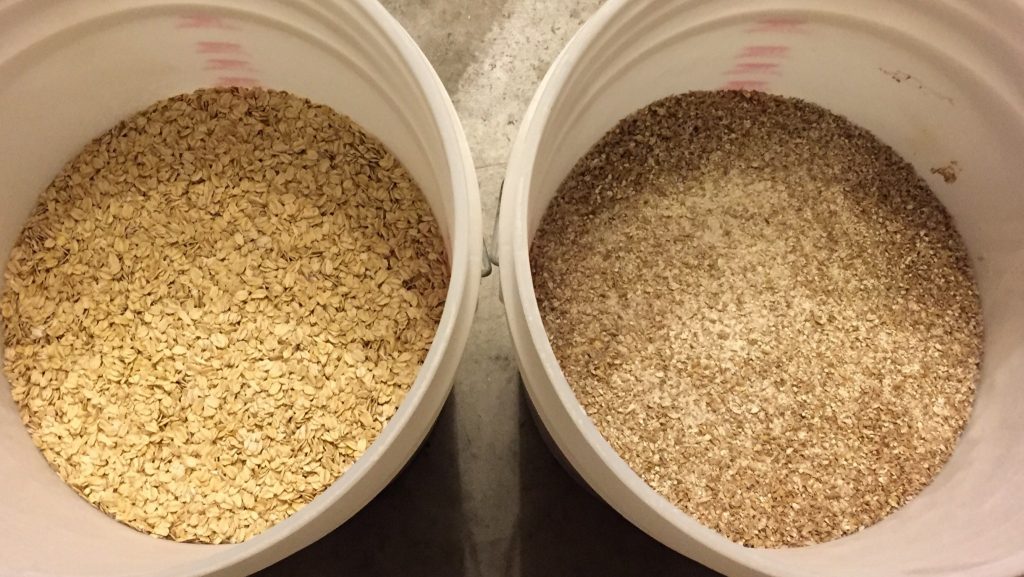
Since these would both be 5 gallon batches, I opted to use the no sparge method and collected the full volume of brewing liquor for each into separate kettles. The chemistry of the water used to make “proper” examples of NEIPA is often said to be far richer in chloride than sulfate, and so using Bru’n Water, I adjusted each batch to a sulfate to chloride ratio of about 0.38 (71:186). Around noon the next day, I began heating the strike water for the oats batch first then, 20 minutes later, doing the same for the batch with no oats, lamely referred to as “NOats” henceforth.
When the temperature of the water was slightly higher than suggested, it was transferred to a mash tun and allowed to preheat for a few minutes before I incorporated the grains, both batches ultimately settling at my target mash temperature.
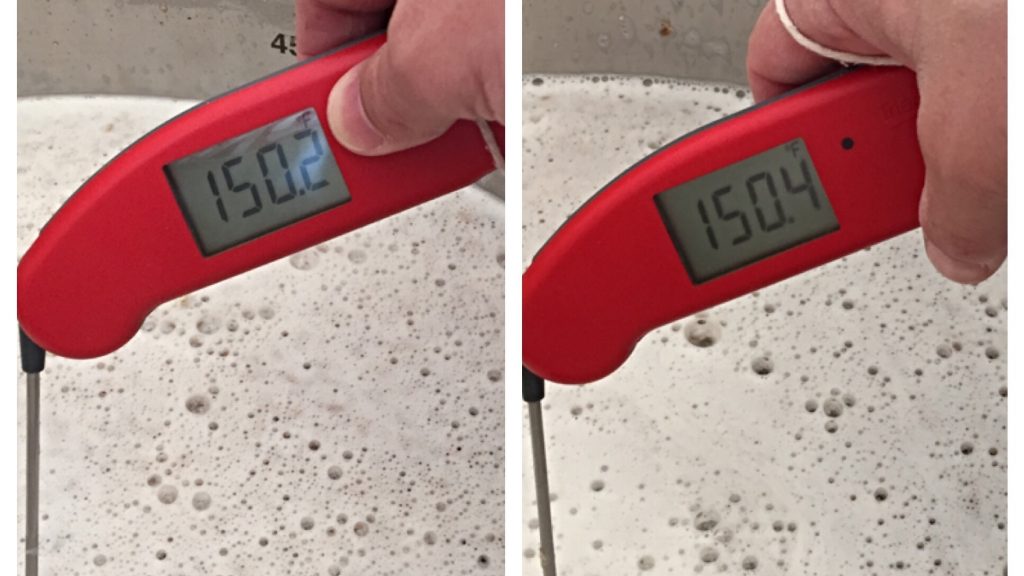
Both batches were mashed for 60 minutes and stirred briefly every 20 minutes throughout.
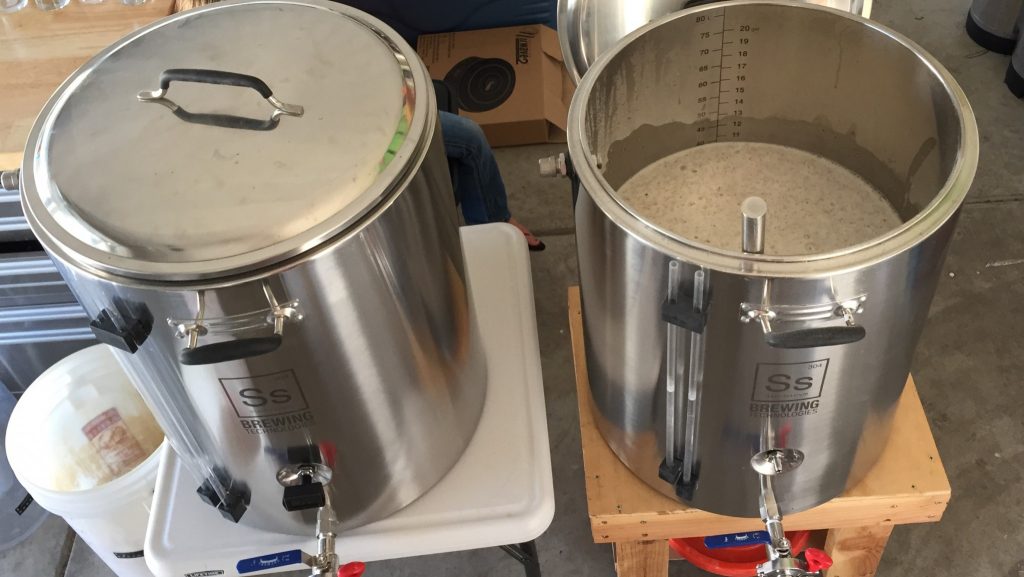
I took the time to measure out hop additions as the mashes rested.
Once the mashes were complete, I performed a vorlauf then began collecting the sweet wort, noticing what seemed to be a subtle and unsurprising difference in color.
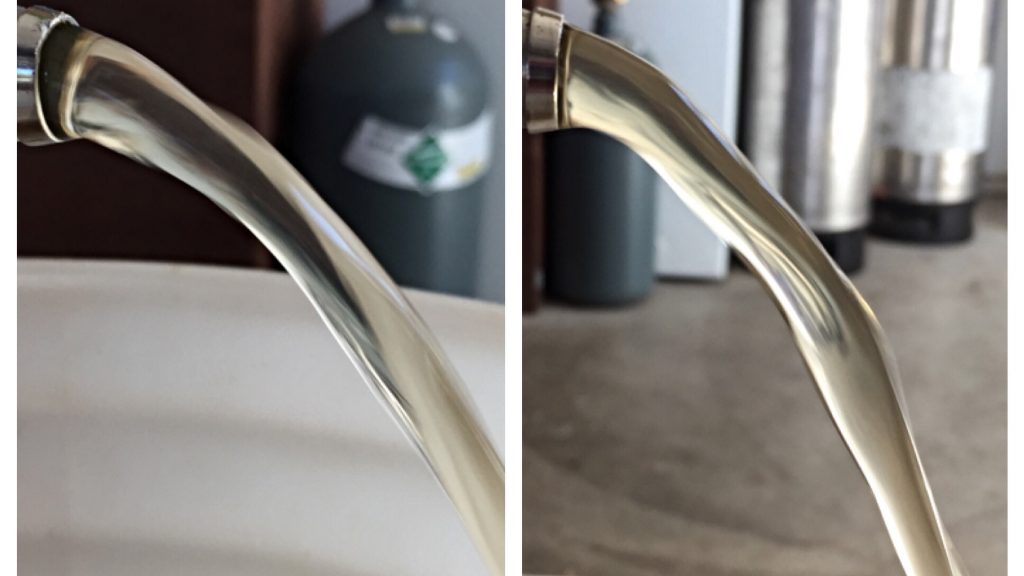
Hops were added at the listed times during separate 60 minute boils.
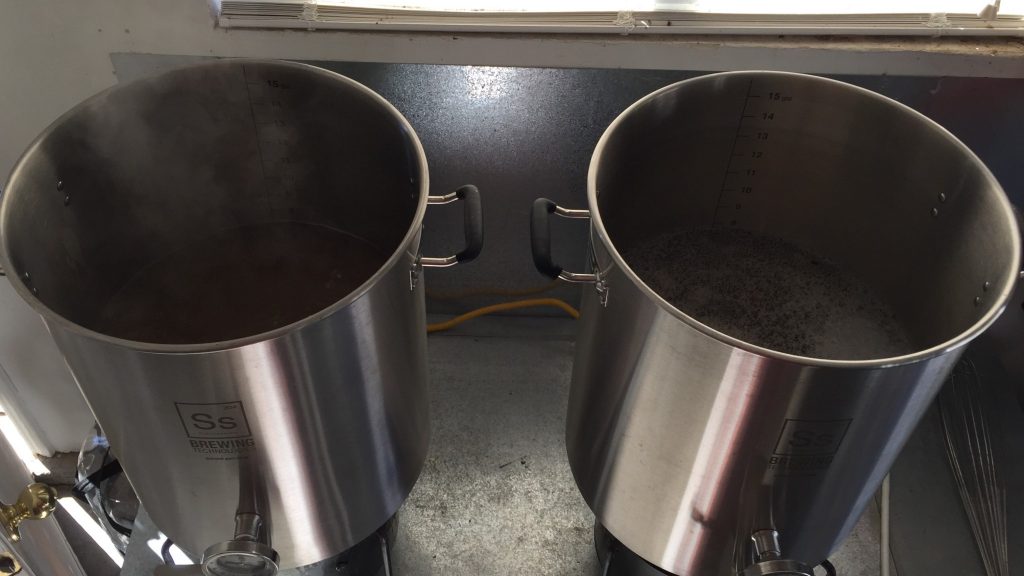
Replacing hop stands with later kettle kettle additions meant the wort was chilled immediately at flameout, quickly dropping to about 72°F/22°C.
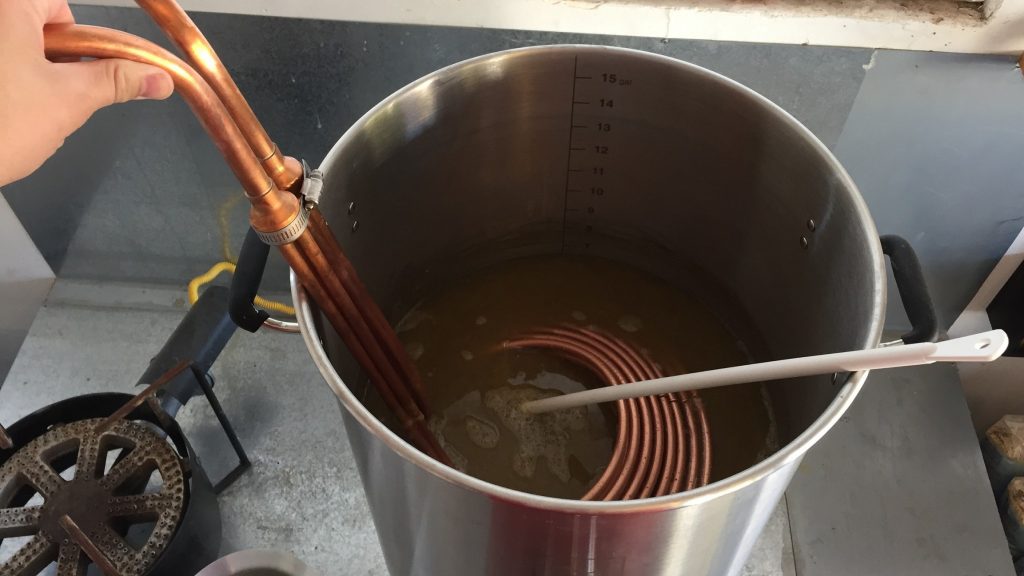
A hydrometer measurement at this point revealed a slight difference in OG, with the Oats wort clocking in a little lower than the NOats wort.
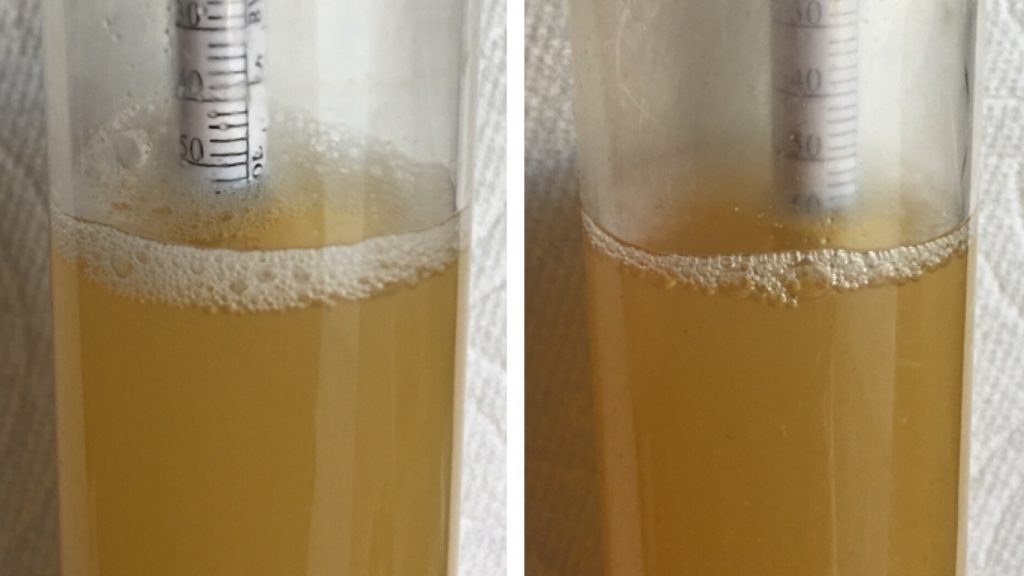
Separate 6 gallon PET carboys were filled with equal amounts of wort from either batch then placed in a temperature regulated chamber to finish chilling. While waiting, I stole some yeast from the starter to reserve for future use then split the rest evenly between two smaller flasks in preparation to be pitched. It took about 4 hours for the carboys of wort to stabilize at my target fermentation temperature of 67°F/19°C, at which point the yeast was pitched. Both beers had developed healthy kräusens and were bubbling like mad 18 hours later.
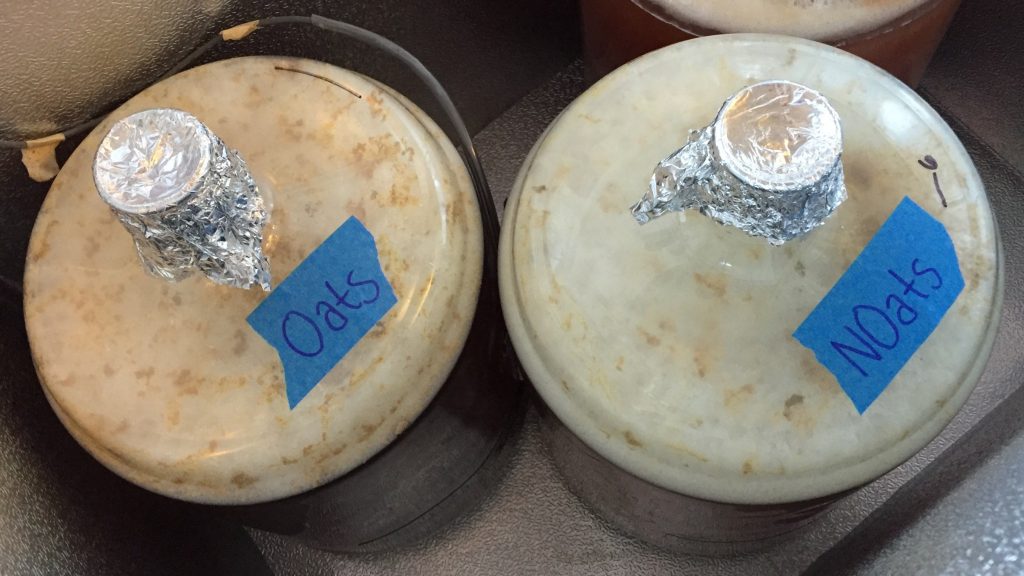
Yet another unique aspect of brewing NEIPA is adding dry hop additions during active fermentation, a step purported by some to be the cause of the so-called “juicy” hop character due to a process referred to as biotransformation. Because of this, I added the dry hop charges 2 days after pitching yeast, when it seemed the kräusen had peaked, about 4 days sooner than I would have for a West Coast IPA.
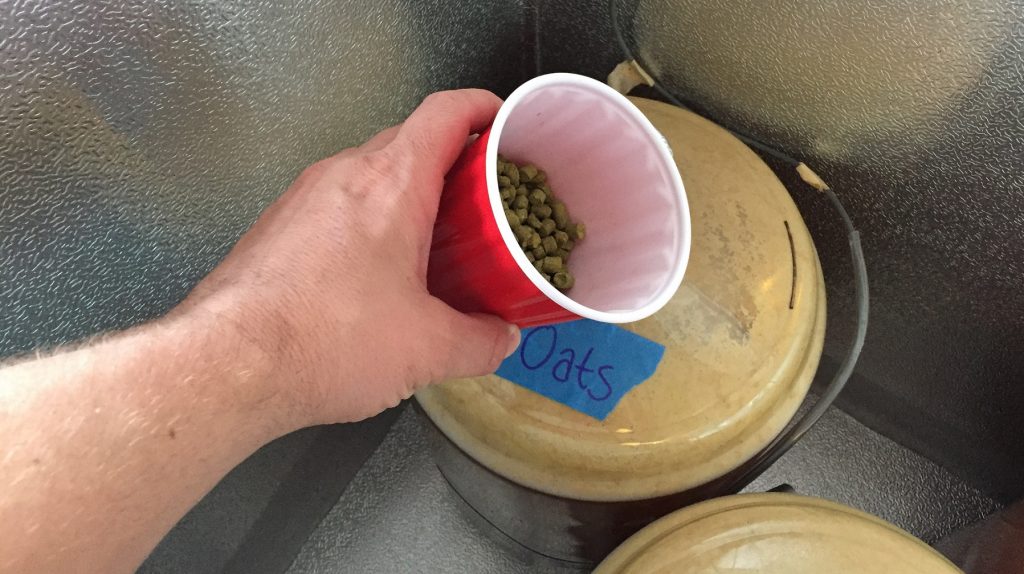
As fermentation finished up over the following few days, I was met with a glorious aroma every time I opened the chamber, which while nice, left me wondering if any would remain in the finished beer. Activity was all but absent a week post-pitch so I took an initial hydrometer measurement that I compared to a second measurement 3 days later, the lack of change confirming fermentation was indeed complete.
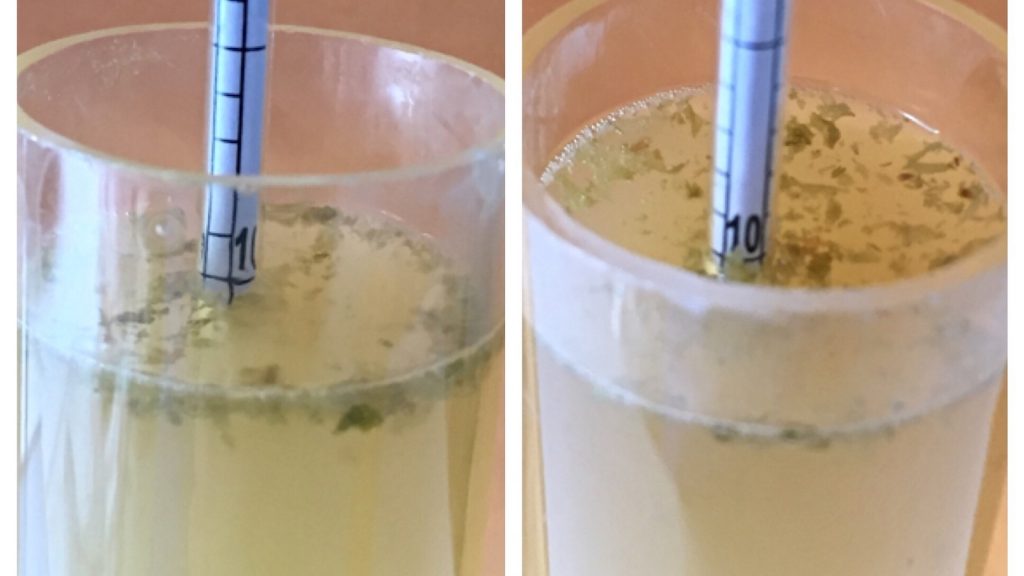
I dropped the temperature on the chamber to 32°F/0°C and let the beers cold crash overnight, forgoing my standard gelatin fining in order to preserve whatever it is some fear is lost by fining. I returned the following evening to keg the cold beers.
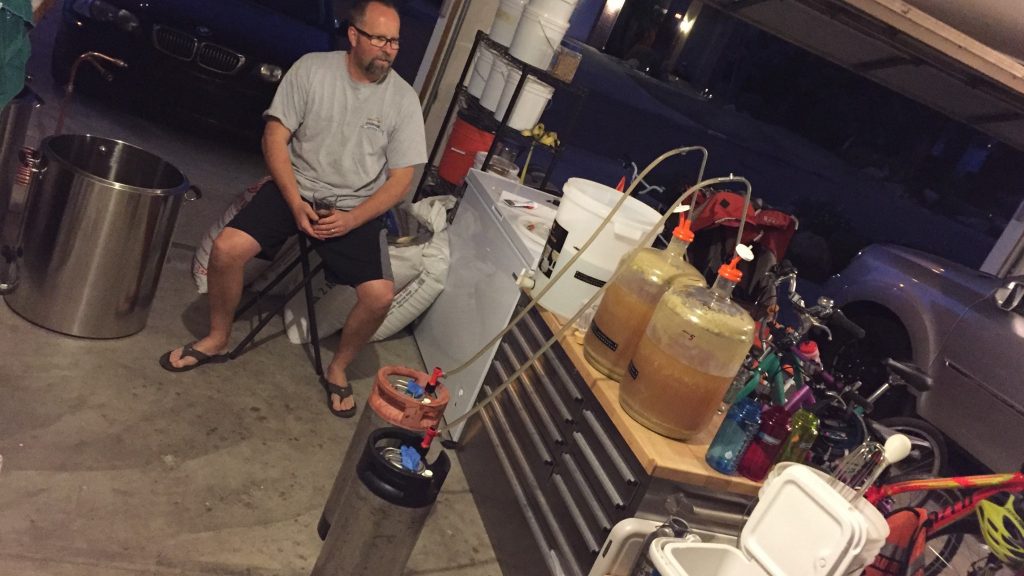
While I’d originally planned to add a charge hops in the keg as well and actually did suspend them in the kegged beer, I quickly learned the fishing line I used disallowed the o-ring on the keg to seal when pressure was applied. Dammit! After removing and tossing over 8 oz/227 g of sopping Galaxy, Citra, and Centennial, I burst carbonated the beers by applying 45 psi of CO2 to each keg. After 18 hours, I reduced the gas to 14 psi where it remained for 3 days until I began serving it to participants. Perfectly carbonated, nice white head with fantastic retention, and hazy as hell. Whatever I did right felt so wrong.
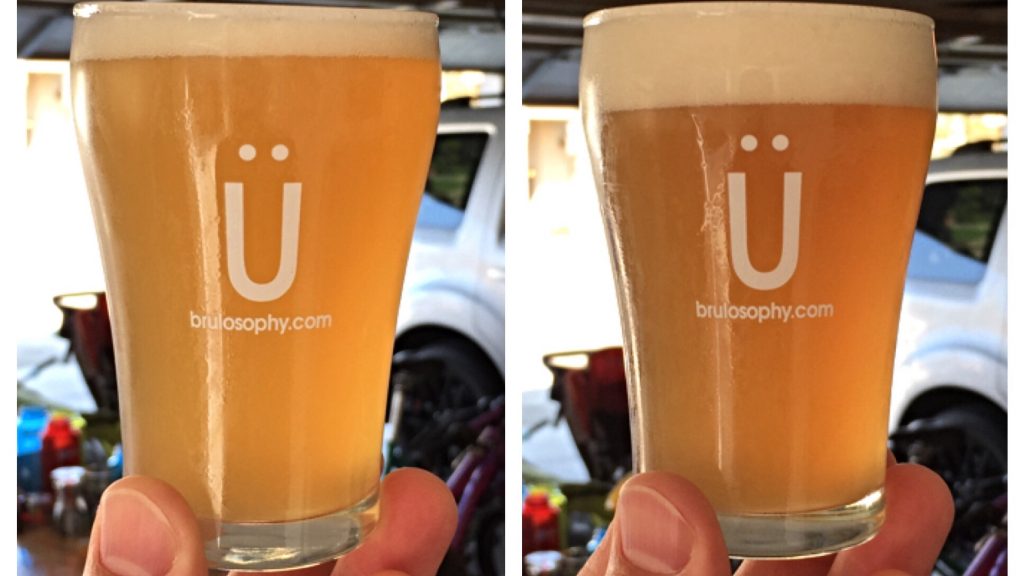
| RESULTS |
A total of 19 people of varying levels of experience participated in this xBmt. Each participant was served 1 sample of the beer made with flaked oats and 2 samples of the beer made without oats in different colored opaque cups then asked to identify the sample that was unique. Given the sample size, 11 tasters (p<0.05) would have had to correctly identify the unique sample in order to reach statistical significance. A total of 6 tasters (p=0.65) accurately identified the unique sample, indicating participants in this xBmt were unable to reliably distinguish a Hazy IPA made with 18% flaked oats in the grist from one made without any flaked oats but an otherwise similar recipe.
This xBmt was discussed live on The Brewing Network’s 11/21/2016 episode of The Session. Adding the data of the 4 blind co-hosts who evaluated the beers, only 1 of which correctly identified the sample made with oats as being unique, brings the total number of participants to 23 with 12 (p<0.05) expected correct responses in order to reach statistical significance and 7 (p=0.69) actual correct responses. Ultimately, the performance of this set of participants roughly approximates the larger dataset’s inability to reliably distinguish between the beers.
My Impressions: Despite all the shit I’ve talked on hazy IPA over the last few years, I was pretty excited to brew one for myself and especially curious about the impact of flaked oats. As far as my ability to distinguish between these beers goes, I could reliably tell them apart based on appearance alone, as the batch made with oats had a lighter color that, to me, made it look more juice-like and less murky than the one made without oats. Other than that, I couldn’t do it. I didn’t necessarily expect them to taste and smell different, which they didn’t, but what really got me is how remarkably similar they were in terms of mouthfeel, both possessing what I could see being described as soft or even creamy with a luscious body that I always presumed came from flaked oats.
I feel I owe it to my hazy IPA loving friends to share that this was one of the best IPAs I’ve made. Yeah, I know, it almost hurts to say it. I enjoyed it so much that I started drinking pints before data collection and worried I might not have enough if I didn’t practice some moderation. I also don’t brew very much IPA. Still, Citrus and tropical fruit stole the show with whispers of earthy dankness I believe came from the Galaxy. So, so good. At least for the first 10 days after kegging. At the time of writing this, the beers had been on tap for exactly 4 weeks and were certainly showing their age, though not to the point of being undrinkable.
| DISCUSSION |
Hazy IPA has permeated the craft beer world and, ugly as it may be to some, is almost certainly here to stay. In addition to its unconventional appearance, this style is lauded for its soft mouthfeel and creamy texture, which many believe to be a function of the high percentage of flaked oats in the grist. However, participants’ inability to reliably distinguish a version of Hazy IPA made with 18% flaked oats from one made without flaked oats sort of throws a wrench in this theory. I’ve used varying amounts of flaked oats numerous times in the past in styles ranging from American Amber to Imperial Stout and I’ve never had an issue with clarity. Since both beers in this xBmt were similarly hazy and neither dropped clearer than the other over time, I’m beginning to question whether flaked oats really does contribute to haze as much as I’ve been led to believe.
So, what is the cause of haze in Hazy IPA? And what about the creamy, “juicy” character so quintessential to this style? While yeast in suspension is certainly a possibility, I’m doubtful because, for one, I’ve tasted yeasty beers many times and don’t enjoy them, plus I’ve yet to have gastrointestinal issues after drinking multiple pints of my xBmt beers. Since all we’re left with is speculation at this point, I find myself leaning toward a couple other explanations. Water chemistry being as imporant as it is, it seems pretty obvious the proportionately high chloride levels used to produce Hazy IPA is responsible for some of the uniqueness, though it may not be a main cause of haze. What I’m most interested in exploring further, a topic that has received little focus up until recently, is the impact of biotransformation that occurs from the interaction of yeast with hops added during active fermentation.
One thing I’m convinced of is that flaked oats and perhaps other similar grains do have an impact on the appearance of the finished beer, just not necessarily the haziness. To me, the darker color of the beer made without oats gave it a murky appearance reminiscent of dirty dish water, while the version made with oats had more of an orange hue that I found much more appealing. It’s because of this that I will continue to use flaked oats in future batches of Hazy IPA.
As is often the case, these results have left me with more questions than answers, a good thing for the curious like me. In addition to its impact on Hazy IPA, I can’t help but wonder what effect flaked oats actually has on styles where it more traditionally makes up a portion of the grist. Could it be that our perception of Oatmeal Stout as possessing a silky mouthfeel and creamy texture is driven more by expectation than reality? I don’t know, but I look forward to trying to figure it out!
If you have experience brewing with flaked oats in NEIPA or any other style, we’d love to hear from you! Please feel free to share your thoughts in the comments section below.
Follow Brülosophy on:
FACEBOOK | TWITTER | INSTAGRAM
If you enjoy this stuff and feel compelled to support Brulosophy.com, please check out the Support Us page for details on how you can very easily do so. Thanks!


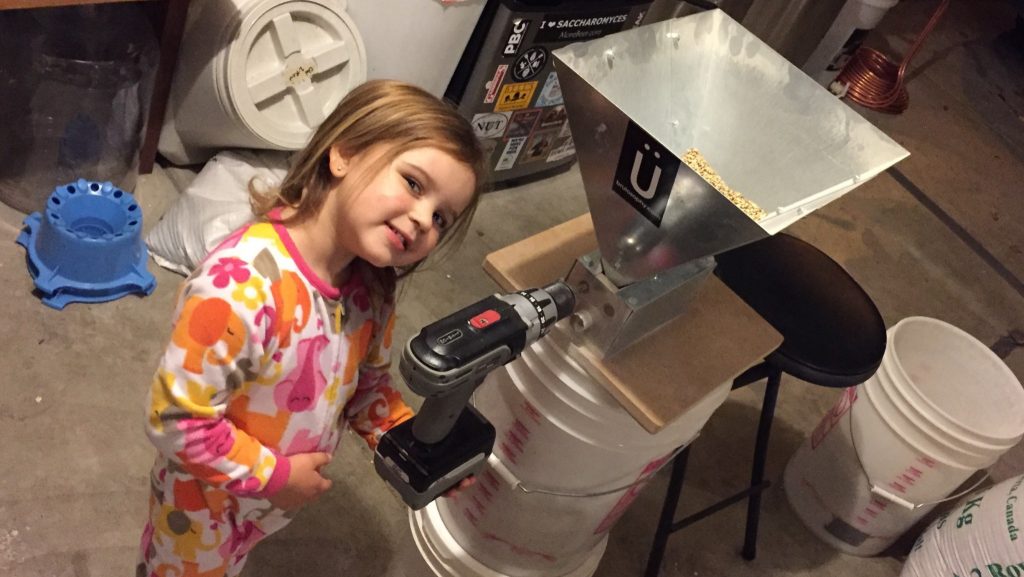
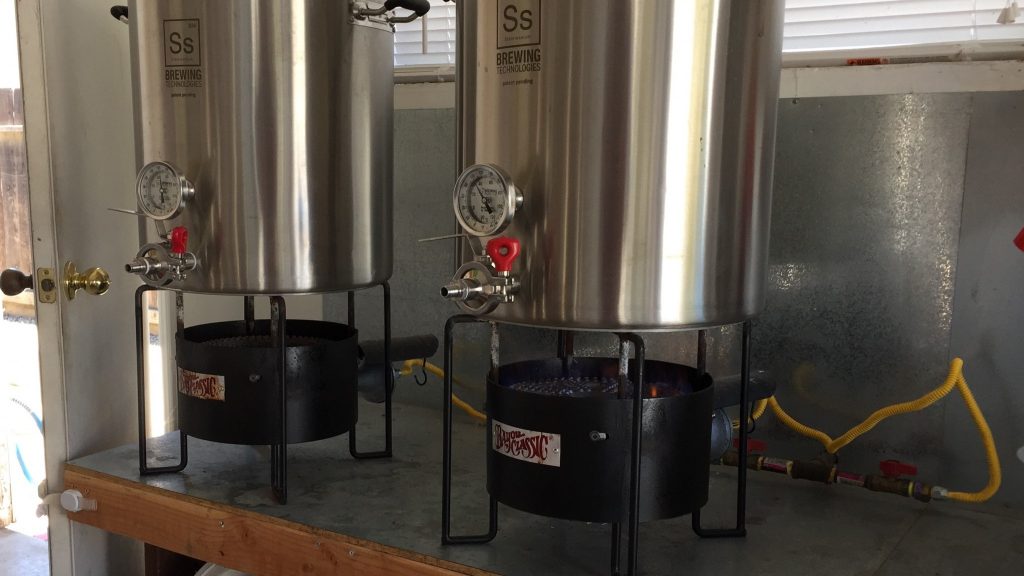
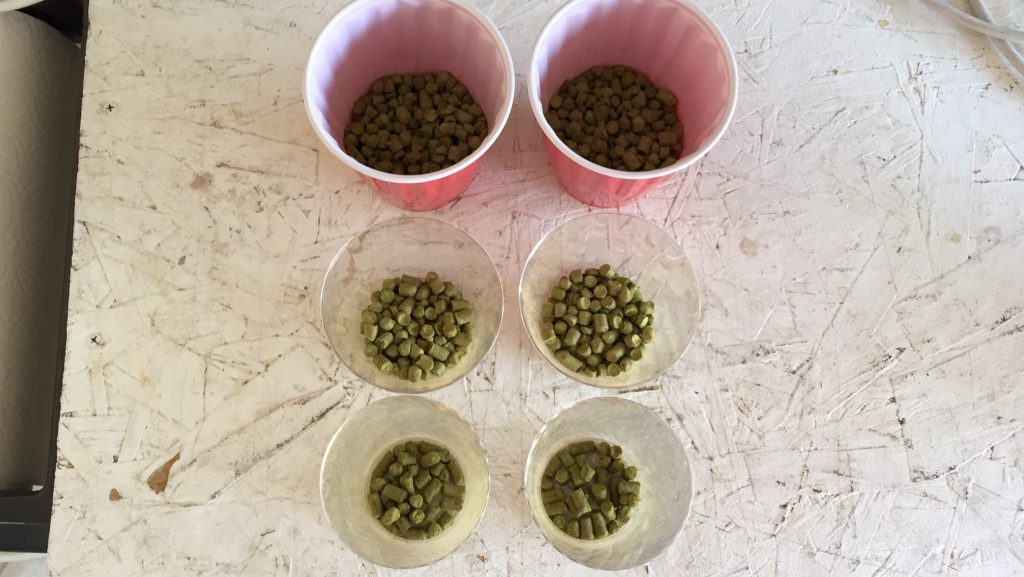









96 thoughts on “exBEERiment | Impact Flaked Oats Have On A Hazy IPA”
You might have given me an explanation for a beer I brewed in the beginning of this year which was also hazy. I had 1 kg of Vienna malt laying around, and I wanted to experiment. So I brewed a tripel from it, and I also decided to dry-hop it. So, I did this, but I added the dry-hop after four or five days of fermentation. I think 1 gram/liter, East Kent Goldings, not more. After fourteen days in fermentation I bottled and let it mature for a month. This beer stayed hazy, and for a long time I thought that I had sparged too hot. But it missed the astringency I had in another beer that was sparged with rather alkaline water, but which was six months hazy.
However, the taste of my “Vienna tripel” was outstanding hop. I took it to a tasting evening and it blew people away.
So, I just might have had the same issue: dry-hopping while the fermentation is still going on gives an outstanding taste, and makes the beer hazy.
interesting!
Dental floss works pretty well to suspend hops in kegs, at least in my experience
I agree and was going to recommend the same thing. It works great I think because of the flat cross section and, of course, it is thin. Recommend the unflavored kind. 😉
Why do you need to suspend it at all? I just stick the hop bag in the keg
“So, tell us about this beer…”
Well is dry hopped with 500g galaxy and dry flossed with colgate spearmint..
Haha!
if you don’t have non-mint dental floss, plumbers tape (PTFE) works really well too
I did something similar this year – brewed a NE IPA with 85% Pilsner malt and 15% Quaker 1-minute oatmeal. My “experiment” was fermenting one with Imperial Barbarian (Conan strain) and the other with US-05. I dry hopped at high krausen as well as after krausen had fallen (in secondary) and then fined both with biofine clear. Both beers were CRYSTAL CLEAR. I should add that my Sulfate to Chliride ratio was 1-1. The beer was only okay, but I think that is chiefly due to my not particularly liking the El Dorado hops that made up 25% of the hop bill.
So did you actually dry hop a second time in the keg or just dip them, try to seal the lid, curse and take them out?
Thanks!
Marshall,
Thanks for another great xBmt and good read!
I live in NE, and have access to these lovely examples of IPA. I also tend to brew my own hazy IPAs in a similar manner. I never use oats, however…. instead I use wheat malt. Not sure if this contributes to the haze or not, but I suspect like your conclusions that it is based more on the hopping (and I think the mouthfeel perhaps has to do with the yeast/attentuation tendencies).
As far as the issue with dry hopping in the keg…. instead of using line or floss, I just mix whole leaf and pellets in my dry hop. The leaves keeps the bag floating – never had a problem! I think the extended dry hop keeps it tasting/smelling great for longer! (if the keg lasts, that is)
Cheers!
Have you tried giving the good folks at Tree House (Monson, MA) a call? Perhaps they’d be willing to enlighten the HB community on how to achieve the characteristic haziness.
I think o achieved it, no?
I’ve brewed this style IPA many times over the last year. The large dry hop addition gives you the haze. The water profile and oats (at least I believed so until this exbeeriment) add the soft and silky mouthfeel. The combo of biotrasnformation and dank high oil tropical hops: galaxy, citra, mosaic, etc., give you that hug aroma and flavor.
I love (hop) hugs
I’ve done huge dry hop additions in West Coast IPA that dropped super clear. Not sure that’s the direct cause of haze.
Was the NE IPA without oats as hazy as the one with oats the entire time the kegs were around? Maybe the higher bitterness/IBUs on the west coast ipa impact clarity somehow? I think people have used US-05 to achieve very cloudy versions of NE IPA. i also leave out any kettle finings now, which may make it hazier over time, not sure.
i should clarify. i think people have used traditional west coast ipa yeast, such as Chico strain, to produce very cloudy NE IPA.
I want to say London III plays a big role.My house pale with WLP002,S-04, and WLP090 has been crystal clear. The mos recent time I used 1318, and it refused to clear up until the keg kicked 5 weeks later.
I think it could be the yeast. 1318 takes forever to clear.
No longer than other strains in my non-NEIPA experience.
Was the dry hop added during active fermentation? There was no wheat or oats in half this exBmnt yet the haze was definitely there. It ain’t the Maris. Only a couple variables in the NOat’s version. One thing that is done every time with this style is a big hop addition during peak fermentation. That or use a yeast that typically drops clear in one and the typical London III in the other. Yeast or Hops or both AT peak fermentation. Anyways, awesome site, awesome exbeeriments. Keep it up!
Great xbmt! I recently have been suspecting that the “juiciness” in NE pale ales has been coming from two things. More residual sweetness when compared to west coast IPAs. As well as more clorides, which I personally think allows the flavor of beer to linger more on the palate, vs gypsum forward beer that tend to be more snappy and drying.
Excellent write up really enjoy the xBeeriments, especially this one. as i am on my 3rd attempt at a gret NEIPA. All have turned out great with only minor tweaks needed.
One thing I have found in my research on how to brew a NEIPA is that alot of these NE breweries claim or are thought to be using wheat flour in the mash as it adds to the haze and are more foam positive (than wheat itself) giving the beer a more silky smooth mouth feel.
Something to keep in mind/try.
Cheers.
Oppositely, I have found, at least initially, very few were using it. People started using it as a guess at how to emulate some of the beers.
I can definitely see an oatmeal stout without any oatmeal experiment in your future.
The haze is caused by hopping post boil and not fining – no other causal explanation needed. It should brighten somewhat over time.
Maybe that is all there is to it. I have been wondering if there are other variables that impact it some, such as pH, minerals and yeast strain, but I am wondering if it isn’t just lots of hop haze, some yeast and no usage of finings after the boil and in some cases no finings during the boil.
I’m not sure it’s that simple and plan to continue exploring!
Did it stay very hazy or get more clear over time?
I think you’d need to compare dry hopping during krausen to normal dry hopping to see if biotransformation is real.
man, that some interesting stuff.
I always thought that the oats were responsible for the majority of the beer….. but now you’ve got me doubting that.
My thoughts on the stuff I’v done in recent time,s suggested that there was some kind of reaction between the oats and the hops….. but now its possibl the reaction is between the hops and yeast. during fermentation (obviously removing the yeast from suspension as far as possible)
Might be time for another beer of the same style.
I’m hypothesizing it’s the biotransformation dry hop.
Makes me curious how the timing of primary dry-hopping can be modified to increase hop flavor
Cloudwater brewery in the UK did a biotransformation experiment with two beers hopped at different times and released both commercially. Interesting result regarding clarity:
http://draftmag.com/hop-compound-biotransformation/
You can find a number of scientific papers on biotransformation of hops compounds, but I’ve yet to find one that blatantly says that the compounds change the way light passes or doesn’t pass through the beer. Doesn’t mean it doesn’t happen of course.
I’d be interested to see if (and this is grasping at straws) hopping during active fermentation, i.e. when yeast is in suspension, somehow keeps more yeast in suspension. A simple look under the microscope would be all that is needed.
All that aside, no detectable difference due to 18% oats is fricking amazing. Does London Ale III produce so much glycerol that it already seems silky? Does so much hopping produce silkiness? Do oats even produce silkiness or is that a bunch of shit? Awesome stuff!
I’m totally with you, these results surprised the hell out of me! I’ve read a few research papers on biotransformation of hop terpenoids and likewise found nothing regarding impact on appearance, which to me simply shows how little focus we’ve given this increasingly interesting topic.
I’ve said it a few times, but we are actively working on designing an xBmt targeted precisely on the impact biotransformation has on all aspects of beer. The difficulty in ensuring any differences are confidently a function of the biotransformation and not something else, and it’s looking like the best way around this is to brew 2 batches 2-3 days apart. For science…
Scott, Mind sending me over a few that you can recommend?
mwfrazer at g mail
Love the discovery that the silky/creamy mouth feel from oats is just another imaginary effect spread by internet hearsay.
That is interesting. If you touch the wort from a 20% flaked oat batch though, it feels really, really slimy! I thought maybe that was detectable on the tongue, maybe not.
Is the sliminess still there in the beer though? I’ve brewed with oats (5-10%) and haven’t had slimey beer.
I haven’t really felt the beer. I just happened to get my hand into my wort on my last 20% oat flake beer, and I was shocked how slimy it was
Absolutely. Forget the oats,and definitely the wheat flour people are employing. The mouthfeel can be achieved with all barley grist.
I’ll fix the dry hop problem for you! Take a small hose clamp and clamp it to the underside of your relief valve on the keg lid. Tie your hop bag string to the clamp! just be sure to leave very little excess string as it can get sucked into the valve.
I use pin lock kegs, no PRV…
Another great exbeeriment. But you don’t seem to be touching too much on what part the choice of yeast played in the end result here? You focus on it not being yeast in suspension contributing to the haze or mouthfeel, which makes sense given 1318 is a high flocc’er. But perhaps it played a big part in how it fermented the beer, and how it reacted with the dry hop during ferment? Would love to see a test with two identical NEIPA’s, one fermented with 1318, the other with a US-05 or equivalent, with the same dry hop during ferment regime.
Check out this awesome thread on HBT about NE IPA:
http://www.homebrewtalk.com/showthread.php?t=568046
People have used all sorts of yeast in these NE IPAs with great results. All will likely be hazy, but they will have different yeast flavors. people say 1318 has a characteristic tartness (and i say it has a lot of peach/apricot). i think most agree us-05 is very clean with an emphasis on more of a dry,bitter, crisp finish (that i don’t like in my NE IPA.)
I’ve started using a high percentage of flaked oats in my brown ipa and in an irish red and I think it does give you a smoother and bigger mouth feel. And with gelatin I still get a clear beer.
Dry hopping adds some haze, that much we know- but that can be mitigated (or resolved) with finings, lagering, etc. I’ve done my own xbeeriments on what causes haze in NE IPAs, and based on my conclusions in corroboration with Marshall’s, I think the haze comes from the perfect storm of the water profile (low sulfate to chloride ratio), the London ale 3 yeast, aggressive dry hopping, and no finings (obviously oats, wheat, and flaked barley don’t hurt either!)
Interesting stuff. I’ve made 2 x NEIPAs (although one was more of a American Pale Ale) and they turned out great, hazy and exactly as expected.
The thing is, they were made much the same as a I would a regular IPA and only the yeast was changed (I used TYB Vermont Ale). No oats. No dry hopping till after active ferment was over. So in my mind it’s the yeast.
This is fascinating, thanks Marshall. I’m brewing my first NE-IPA this weekend and used the recipes in the recent BYO as a starting point for mine. Interestingly, of the five beers in that issue, only Treehouse’s Julius uses flaked oats, and at about 2%, add in the oat malt, its 10%. Two of the beers use wheat malt, another oat malt, and the Focal Banger, neither. Additionally, four of the five had sugar additions. I’m surprised that doesn’t thin the body too much. Like Marshall, I’m making a huge 1318 starter, but I was planning on the first dry hop at day 4 of primary, then another round at day 8. No finings. And my water will be 0.3 SO4/Cl. Reading this gives me great confidence this initial batch will turn out great. But there are obvious variables which may, or may not impact final flavor, such as, timing of dry hop addition: high krausen, or declining. Second additions, as I’m doing, or not.
From what I’ve read/heard the chloride levels are way higher. Like 300-500ppm, I believe some even higher… I’ve been wondering if the the absolute level of chlorides is the reason for some of the haze, as moderately elevated chloride levels can impede yeast flocculation, and this is way past moderate.
On the mouthfeel side the elevated chloride levels could contribute to the formation of glycerol derivatives, such as glyceryl chloride, or produce higher glycerol levels by another mechanism. *science needed*
Maybe a batch with say a 50ppm chloride level split and one sample adjusted to 500ppm prefermentation. See what that feels like. Of course adding chloride adds hardness (from the calcium or magnesium it’s bound to), but that’d be a whole nother other evaluation.
It strikes me that a good follow up would be to test whether the haze is what makes this recipe great. You could repeat this with a hazy (unfined, optionally with oats) vs clear (fined) variant and see if people can tell the difference and which you prefer.
We did an xBmt at Homebrew Con this year comparing a gelatin fined NEPA vs a non-fined version. No difference flavor, aroma, mouthfeel… or appearance.
This is the hardest xBmt for me to believe. I have to try it; I’m just afraid to ruin half of my beer. 🙂
I brewed a IPA with 50% wheat to test if I could get haziness without dry hoping. The beer was not dry hopped and then keg without fining agent. The beer turned out super clear after few glasses. I then dry hop in the keg with a nylon bag, the beer was hazy for half the keg and then clear again. I do not think keg hopping is the answer to permanent haziness in beer. I’m starting to think the NE haze may come from big dry hoping during forced carbonation.
Did you use wheat malt or flaked wheat? I also did a 50% flaked wheat IPA, and it was awesome. it was super hazy though, the entire time. I don’t hop in the keg anymore, as I generally don’t like the character it seems to give to the beer. If you dump in a ton of hops in the primary, it should have quite a haze for a long time.
It was wheat malt.
Not sure why the focus is so much on oats in the community. Hill Farmstead never uses oats in his hoppy ales, and is what I consider the quintessential NEIPA. Probably the first, although some may consider Alchemist, or if you like to go back to the Vermont Pub and Brewery being the first to originate this style. The mouthfeel on Shaun Hill’s beers have always been there regardless of what he uses, and it’s certainly not from oats. I think a lot of people get too caught up in the “hazy”, and focus too hard on it.
Oh, Marshall, it’s adorable you think that’s a hazy beer. You should come visit; some of our beers look like the bartender poured a mix of orange juice and house paint.
RE: The haze, my theory – purely anecdotal from my own attempts at the style – is that the biggest factors are dry-hopping during active fermentation of a low-floc yeast, and a massive amount of dry hops (usually two different additions). I’m brewed with/without oats and with/without fining and the haziest IPAs are the ones with the earliest first hop additions.
Marshall, I’m having trouble with your findings in this xbeeriment. Particularly, asking the participants to identify which beer is more “unique” doesn’t really tell us anything. Did you define what “unique” meant in the context? What are we basing “unique” on? I think this is a glaring miss.
Was there a particular reason you asked participants to identify the “unique” beer vs. just asking them to compare mouthfeel or haziness? I won’t pretend to know statistics and how to run studies, etc., but I don’t think the results accurately reflect what was expected to be measured.
Also, your beer setup is awesome! Do you boil in your garage with standard propane burners?
Thanks.
In sensory analysis, it’s generally deemed important to keep participants blind to the variable, which also means not giving them any hints as to what the variable might be. It’s for this reason participants are simply provided 3 samples, 1 different than the others (aka “unique”), and asked to try to distinguish the different sample based on aroma, flavor, and mouthfeel. Blindness like this is the standard.
That said, we’re currently working on compiling data to test out the idea that “sightedness,” meaning participants are actually told what the variable is, has some impact on their ability to distinguish the unique sample. We shall see!
Those are propane burners adapted for natural gas, I love it 🙂
Nevermind, I got it. They are selecting the unique beer out of the three. Two are the same, one is different.
Based upon this xbmt, I went ahead and dryhopped into my vigorously fermenting IPA. It was only a total of 2 oz to your 4oz, but I do like the idea of the oxygen scavenging at this stage as well as the possible uptick in “juiciness”. I’m interested to see if the clarity is effected. Good stuff!
Hi Marshall,
Thanks for taking the time to do the experimentl.
I first learned about the experiment by listening to the results in the Brewing Network. I see a problem with the process used in your experiments; this problem is the validation of the media in which the variables are compared. If your experimental design states that your media for comparison is a NE IPA, then it is a precondition of your experiment that you brew a very good control NE IPA (how this is measured is arguable but for the sake of argument, I would say a BJCP score of at least 35 points).
Because you do not publish this information, I am forced to go with comments from the blinded testers, and during the program one taster thought it was a pale ale, another one thought it was an amber ale, and a third one agreed with the amber ale description.
Well, in honesty, if your NE IPA tasted as an amber ale, it failed to be an adequate control, and the results of the experiment are not valid.
I remember another experiment presented in Basic Brewing in which the control beer of the experiment was to be a Kolsch, that per James Spencer was a tasty Trippel.
In summary, you cannot deviate from your experimental design, you need to validate your control in some way. Eg, get two BJCP judges and have them provide a category for the beer and score it in that category. This category has to be the same category you intended to brew or something very close –a Kolsch can be confused with a blonde ale but not a trippel– and get a minimum score for the experiment to be valid.
With kind regards,
Ricardo
Hey Ricardo,
Thanks for the feedback. With all due respect, serve any panel of truly blind tasters any beer and ask them to determine the style, you might be surprised with how difficult most people find the task. I’ve been on both sides of that one and was certainly shocked myself.
Also, we don’t usually package and ship our beers off for tastings, which adds a whole new set of potential extraneous variables, hence the reason I didn’t include their data in the results. Plus, those beers were a bit old, I told JP as much, and it sounds like they’d fallen off a bit.
On another note, I just listened to that BN show. Those guys are such opinionated, ignorant assholes sometimes. “Oh, an NE IPA is like a baby IPA before you step up to a West Coast IPA.” Fuck you. They are very different and neither is inherently superior. Self-righteous douches if you ask me.
The other thing I noticed is that your IPA seemed to go bad pretty quickly. I wonder if there is more oxygen getting into your beer somewhere in the process. I think you should be able to get at least 4-6 weeks in the keg with really great tasting beer. Bottling, shipping and warm-storage time probably killed those samples for that show though.
Hi Marshall,
I understand it is a predicament, but because it is a difficult problem, you cannot just ignore it.
An unwritten and unvalidated premise of your experiments is that the beer that serves as control is a good beer. Without validating this premise, you cannot tell whether people could not tell a difference because there was none or because compared to off flavors in the beer, the difference being tested was minor.
Please do not take this as impolite. I am not saying your beer was bad (could have been a 50 or could have been a 13), but that if you do not somehow objectively prove the beer is good, you can never discount the possibility you did not find a significant difference because the control beer was a bad beer with too many confounding off flavors, so you need to address this problem in your experiments 🙂
Best wishes for the holidays, and thanks for all you do for homebrewing.
Cheers,
Ricardo
There’s really no good way of objectively proving a bet is good, particularly given the subjectivity of preference. Not that it means anything, but everyone who participated in the actual xBmt 3 weeks before the Session really enjoyed the beer, in fact, 3 of my closest friends thought it was one of the better IPAs they’d had in awhile. I don’t feel it’s necessary to say that kind of stuff, partially because it seems like
I’m bragging, but also because I could easily lie about it.
I’m planning on brewing my first NE IPA and I’m also new to making water adjustments. Starting with 100% RO water I used EZ Water spreadsheet trying to achieve the same profile as the recipe above with the following additions:
Gypsum: 3.75g
Calc Chloride: 11.95g
Epsom Salt: 0.45g
Baking Soda: 0.75g
Lactic Acid: 1.25ml
This should get me the following profile:
Mash PH: 5.53
Ca: 131
Mg: 1
Na: 11
Cl: 185
SO4: 71
SO4 to Cl Ratio: 0.38
Does this look right overall? Also, Is the baking Soda necessary to add the Na or can I omit that? Thanks!
Looks good! I wouldn’t worry about adding the baking soda unless you need alkalinity, which I’m doubtful is the case.
Awesome! Thanks for taking a look.
When I brew with oats (wit or a stout) I find that the head on a poured beer disappears very quickly. I have assumed that this is the result of the fat / oil content in the oats and have now stopped using them. Did you find any difference in the stability of the foam for these 2 beers?
Likely as a function of the high hopping rate, I didn’t notice any negative impact on head, and both beers seemed to have similar foam qualities.
I’ve noticed the same thing. The head is not as good when using large quantities of oats
Just getting into water manipulation – when you list the water profile it doesn’t include a number for bicarbonate. How should I handle that number for the NEIPA style? Thanks!
Bicarbonate isn’t terribly important, whatever you’re at after adding all your gypsum and CaCl ought to be fine, assuming your water isn’t super hard.
Thanks for the quick reply. My water is Ca 37 | Mg 12 | Na 9 | SO4 27 | Cl 14 (bicarb = 138). I should be OK then I think. Thanks.
You good!
Hey Marshall,
Quick question please: I am replicating this recipe given your endorsement as one of the best IPAs you’ve ever made, and I’d like to know what the additional dry hop charge was that you attempted post-ferm, but had to toss. You said 8 oz, so was it 3 galaxy, 3 Citra, and 2 centennial? Also, how much of an impact do you think that brief dry hopping even had on the final product?
Many thanks in advance!
4g Galaxy, 2g each Citra and Centennial.
FWIW, it looks like you said grams here, but oz in the original xbmt post, so I did 8 oz dry hop in the keg and it added so much bitterness it made the batch undrinkable, even after letting it mellow for weeks. I did happen to pull some tastes before adding this charge and it was damn good, so for anyone copying this recipe, layoff the additional dry hop charge a bit, if not entirely. I’ll be trying it again like that at some point…
Hey Marshall,
First off all of your work here is awesome and I have learned a ton so thanks for all you do!
I am excited to try out this recipe based off of your glowing recommendation. I have an event in about 6 weeks that I thought it would be perfect for. However I will be away on a business trip for 4 of those weeks so whatever I make is going to sit in the primary for 4-5 weeks. I have never let something dry hop for that long and your exbeeriments say that after 2 weeks the flavor profile starts to change a bit. Do you think that the extended time would be detrimental to the beer or is it worth giving a shot?
Thanks!
Man, I really don’t know, but I’m compelled to believe the hop would fade in that amount of time.
Yeah that’s what I am worried about, I have done quite a bit of searching and haven’t found anyone who has left one in that long after dry hopping. I think I am going to go for it and worst case scenario I learn something. I might have a buddy come over and add a second helping of hops 5 or 6 days before I come back just to see what happens.
Thanks!
Hi Marshall,
Once again, a great and informative Xbeeriment. Just a quick question related to your statement:
“At the time of writing this, the beers had been on tap for exactly 4 weeks and were certainly showing their age, though not to the point of being undrinkable”
You talking oxidation? Or significant loss of hop aroma/flavour?
Thanks again!
I’d reckon the latter, but in not certain.
Just finished fermenting your recipe, bottling tomorrow – it tastes lovely out of the fermenter 🙂
Maybe I missed this but did you use Irish moss/whirlflloc?
Not concerned about the affect on the xbmnt but would like to copy your recipe as closely as possible because of the words “Best IPA I’ve ever made”.
Did you notice if either beer had better head retention?
Marshall,
I agree with you… Probably one of the best IPAs I’ve ever tasted.
I followed the recipe and process exactly, including water treatment.
It is both refreshing and flavorful…. and an especially great beer for the warm weather months.
Not sure I’d change a thing with this recipe. I might try keg hopping it
with a small amount of the same mix of hops in the recipe but this would only
be to further satisfy the hop heads who always want more. I thought your 8oz of
dry hops was way too much and I was thinking no more than 1-2oz.
Great recipe and nice intro into biotransformation.
This one belongs on your favorites list.
Steve
Raleigh, NC
Very nice post, thanks a lot!:)
I will definitely try to brew this beer. Just to be sure, i’m a newbie at brewing. Is the high chloride level chosen to accentuate the flavor and fullness of the beer, or is it a product of high levels of sulfate in your water, which makes it necessary to achieve the sulfate to chloride ratio? The reason I’m asking is, that I can see, that Bru’n Water only recommends up to 100ppm of chloride.
My tap water has 27ppm of sulfate in it. Shall I just tweek my chloride to get the same sulfate to chloride ratio as you. Or should I go for all the same mineral values as you?
Regards from Denmark
Very Cool… what was your mash temp?
150F
I started mine at 153F and ended at 150F due to losses with my mash vessel.
I am a NEIPA hater not because all of NEIPA are $#!+ but because although I’ve had excellent ones from breweries such as Pure Project and Brewerji West, I’ve also had terrible ones. I feel that the style is still undefined.a good brewer/brewery will plump out a good any style but i think too many don’t know how to brew NEIPA and crate a hazy beer their way such as the wrong way that leads to unfinished bubble gut beer. That’s my beef with the “NEIPA” style. There’s no defined method. Just as your experiment yielded similar results with or without oats. So what’s the key practice to attain the haze. I’ve had some with hop sediment, yeast still in suspension and some that send me to the restroom immediately after drinking while others have wowed me.
That’s the hate for NEIPA for me. Inconsistent brew practices from an undefined style.
Looks like the mouthfeel came more from the water profile than the grain bill. Good work. Thank you!